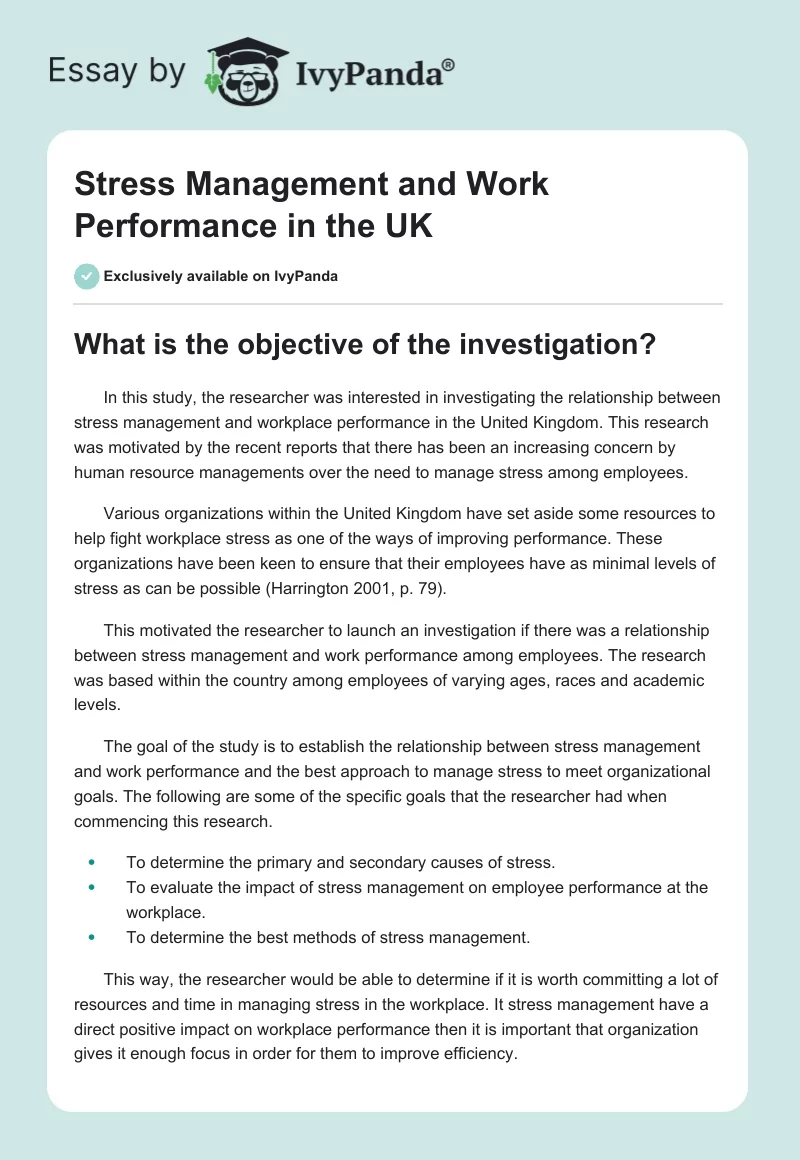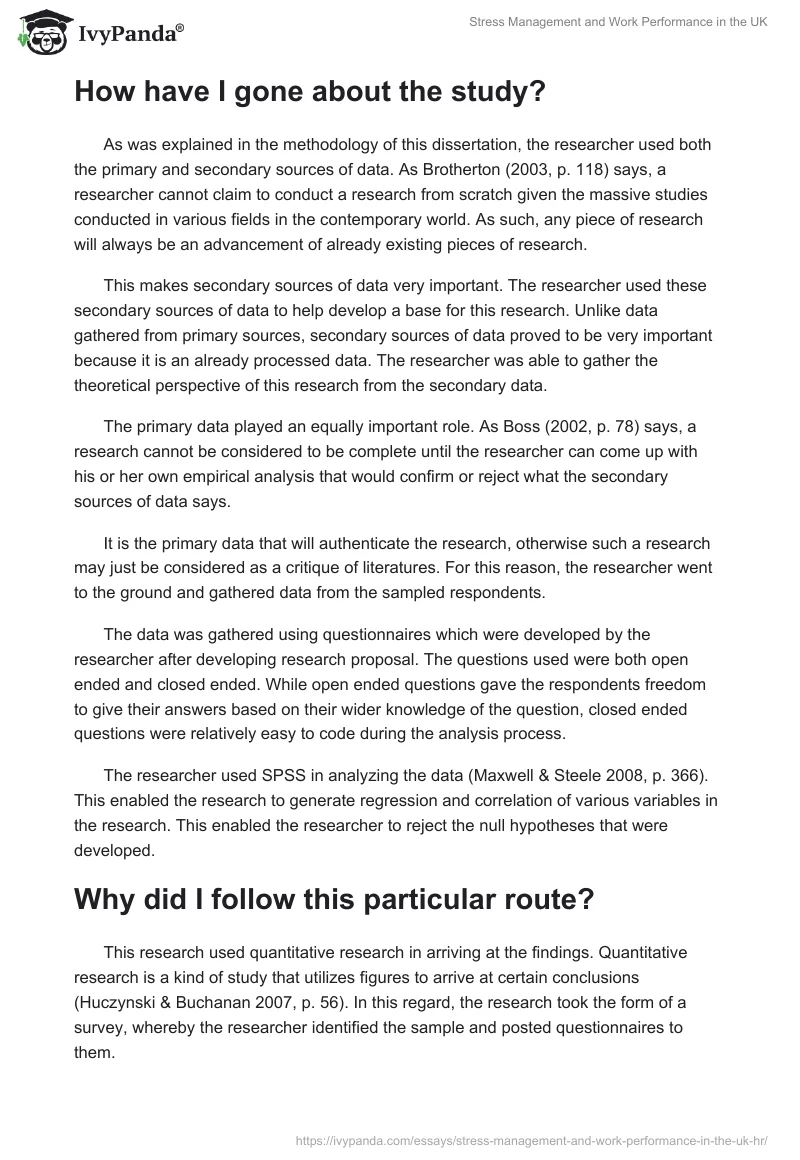- What is the objective of the investigation?
- How have I gone about the study?
- Why did I follow this particular route?
- What principles govern my choices?
- What assumptions have I made and what were my justifications?
- What results did I obtain?
- Will this research solve the problem?
- Are the analyses sound?
- List of References
What is the objective of the investigation?
In this study, the researcher was interested in investigating the relationship between stress management and workplace performance in the United Kingdom. This research was motivated by the recent reports that there has been an increasing concern by human resource managements over the need to manage stress among employees.
Various organizations within the United Kingdom have set aside some resources to help fight workplace stress as one of the ways of improving performance. These organizations have been keen to ensure that their employees have as minimal levels of stress as can be possible (Harrington 2001, p. 79).
This motivated the researcher to launch an investigation if there was a relationship between stress management and work performance among employees. The research was based within the country among employees of varying ages, races and academic levels.
The goal of the study is to establish the relationship between stress management and work performance and the best approach to manage stress to meet organizational goals. The following are some of the specific goals that the researcher had when commencing this research.
- To determine the primary and secondary causes of stress.
- To evaluate the impact of stress management on employee performance at the workplace.
- To determine the best methods of stress management.
This way, the researcher would be able to determine if it is worth committing a lot of resources and time in managing stress in the workplace. It stress management have a direct positive impact on workplace performance then it is important that organization gives it enough focus in order for them to improve efficiency.
How have I gone about the study?
As was explained in the methodology of this dissertation, the researcher used both the primary and secondary sources of data. As Brotherton (2003, p. 118) says, a researcher cannot claim to conduct a research from scratch given the massive studies conducted in various fields in the contemporary world. As such, any piece of research will always be an advancement of already existing pieces of research.
This makes secondary sources of data very important. The researcher used these secondary sources of data to help develop a base for this research. Unlike data gathered from primary sources, secondary sources of data proved to be very important because it is an already processed data. The researcher was able to gather the theoretical perspective of this research from the secondary data.
The primary data played an equally important role. As Boss (2002, p. 78) says, a research cannot be considered to be complete until the researcher can come up with his or her own empirical analysis that would confirm or reject what the secondary sources of data says.
It is the primary data that will authenticate the research, otherwise such a research may just be considered as a critique of literatures. For this reason, the researcher went to the ground and gathered data from the sampled respondents.
The data was gathered using questionnaires which were developed by the researcher after developing research proposal. The questions used were both open ended and closed ended. While open ended questions gave the respondents freedom to give their answers based on their wider knowledge of the question, closed ended questions were relatively easy to code during the analysis process.
The researcher used SPSS in analyzing the data (Maxwell & Steele 2008, p. 366). This enabled the research to generate regression and correlation of various variables in the research. This enabled the researcher to reject the null hypotheses that were developed.
Why did I follow this particular route?
This research used quantitative research in arriving at the findings. Quantitative research is a kind of study that utilizes figures to arrive at certain conclusions (Huczynski & Buchanan 2007, p. 56). In this regard, the research took the form of a survey, whereby the researcher identified the sample and posted questionnaires to them.
In this research, there was need to compare the relationship between variables in order to establish cause and effect. The researcher was interested in knowing how different factors (independent variables) stress management (dependent variables), and how this would then affect workplace performance.
This demanded for a method that would be objective and able statistically to generalize the findings. Quantitative method was found to be the most appropriate method to use in this research.
Quantitative research involves systematic empirical study of a phenomenon by use of statistical tools (McClurg 1999, p. 25). Its main objective is always to employ mathematical theories and models in developing its generalization (Freund & Carmeli 2003, p. 710).
Therefore, quantitative method would help in this research. It would enable the researcher test the hypotheses put forth for validity and allow the use of a sample as a representation of the entire population. It would help the researcher to use the data to compare the performance of specific employees in their workplaces, and the way they manage their stress and how the management helps them in managing their stress.
The quantitative method would also help in knowing if there is any relationship between the performance of the employees at workplace and stress management.
Although qualitative methods was traditionally used in social science and would be appropriate in this research, it is not able to give empirical support for research hypothesis. Qualitative methods explain why a given pattern of events has taken place the way they have (Buick & Thomas 2001, p. 308).
On the other hand, quantitative methods explains what and when of a phenomena. Ethnographic research and phenomenology as approaches of qualitative research would have been appropriate. Ethnography would help in investigation of culture at the workplace that may increase chances of stress among employees (Denzin & Lincoln2011).
Phenomenology would have helped investigate realities that should be addressed by the management in order to successfully manage stress at the workplace. Due to these reasons qualitative method was not employed in the research and the researcher opted for quantitative research.
What principles govern my choices?
As mentioned above, the researcher wanted an approach that would enable empirical analysis of data. This would help in validation of the secondary data that was reviewed in chapter two of this research. The decision to collect data from across the races, sexes, ages, levels of and education was to help determine the social groups that are at greater risk of getting affected from stress.
This would enable policy makers within various organizations in the United Kingdom to know how to approach each group when it comes to stress management (Lazarus 1966, p. 78). This decision was also based on the fact that there is need to be all inclusive because in the current society prohibit any form of discrimination on whatsoever basis.
What assumptions have I made and what were my justifications?
In every research, there is need to develop some assumptions in order to make a research process a reality. Assumptions are always very important when dealing with social sciences. As Belanger (2011, p. 89) says, in pure sciences, it is possible for the researcher to manipulate organisms in the research to fit into the desired condition.
However, this is not possible when dealing with social sciences. This is because in social sciences, the subject of the researcher is a human being. It is almost impossible to manipulate human being when conducting a research. For this reason, it is important to make some assumptions. In this research, it was assumed that stress is the major cause of poor employee performance at the workplace
What results did I obtain?
From this research, the result did confirm the fact that stress management has a direct positive impact on performance at workplace. It was confirmed that the best way of managing stress in the workplace is by identifying the source. When the source of this stress is identified, it becomes possible to address it by eliminating the source.
This is a sure way of ensuring that all the negative symptoms of stress to not affect the effectiveness of the employees in the workplace. It was also confirmed in this research that lack of stress management among employees in some institution in the United Kingdom has negatively affected the performance of such institutions in various fronts.
Will this research solve the problem?
The research has revealed a lot of facts about stress management. From this research, it has come out clearly that for the management to be in a position to succeed in their undertaking, they must fight stress among their employees. This research has given a number of ways through which stress can be managed at workplace for firms within this country.
Are the analyses sound?
The validity of the analysis done in this research has been confirmed. The decision to use quantitative analysis was partly motivated by the need to have a method that can be verified empirically. This makes the results obtained in this research valid. They can be used by policy makers within the scope defined in this research.
List of References
Belanger, C 2011, Our World: United Kingdom, Cengage, New York.
Boss, P 2002, Family stress management: A contextual approach, Sage, Thousand Oaks.
Brotherton, B 2003, International Hospitality Industry: Structure, Characteristics and Issues, Butterworth-Heinemann, New York.
Buick, I & Thomas, M 2001, Why do middle managers in hotels burn out? International Journal of Contemporary Management, vol. 13, no. 6, pp. 304-309.
Freund, A & Carmeli, A 2003, ‘An Empirical Assessment: reconstruct model for five universal forms of work commitment’, Journal of Managerial Psychology, vol. 18 no. 7, pp. 708-725.
Harrington, J. M 2001. “Health effects of shift work and extended hours of work.” Occupational and Environmental Medicine, vol. 58, no. 1, p. 68-72.
Huczynski, A & Buchanan, D 2007, Organizational Behavior: an introductory text, Prentice Hall, Harlow.
Lazarus, R 1966, Psychological Stress and the Coping Process, McGraw-Hill, New York.
Maxwell, G & Steele, G 2008, ‘Organizational commitment: a study of managers in hotels’, International Journal of Contemporary Hospitality Management, vol. 15 no. 7, pp. 362-369.
McClurg, N 1999, Organizational commitment in the temporary-help service industry’, Journal of Applied Management Studies, vol. 8 no. 1, pp. 5-26.


